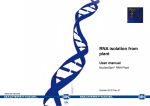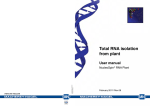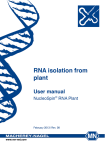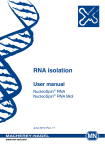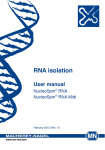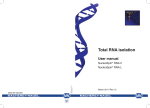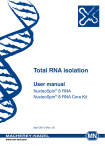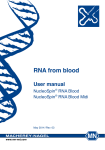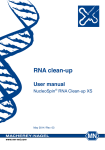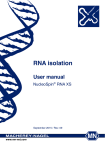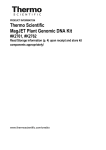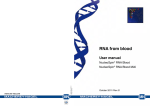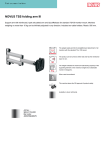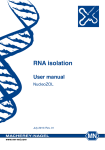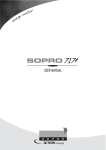Download NucleoSpin® RNA Plant - MACHEREY
Transcript
RNA isolation from plant User manual NucleoSpin® RNA Plant May 2014 / Rev. 09 RNA isolation from plant Protocol-at-a-glance (Rev. 09) NucleoSpin® RNA Plant 1 Homogenize sample 2 Lyse cells 100 mg 350 μL RA1 3.5 μL ß-mercaptoethanol or 350 μL RAP 3.5 μL ß-mercaptoethanol Mix 3 Filtrate lysate 11,000 x g, 1 min 4 Adjust RNA binding conditions 5 Bind RNA 350 μL 70 % ethanol Mix Load sample 11,000 x g, 30 s 6 Desalt silica membrane 350 μL MDB 11,000 x g, 1 min 7 Digest DNA 95 μL DNase reaction mixture RT, 15 min 8 9 Wash and dry silica membrane Elute RNA 1st wash 200 μL RAW2 2 wash 600 μL RA3 3rd wash 250 μL RA3 nd 1st and 2nd 11,000 x g, 30 s 3rd 11,000 x g, 2 min 60 μL RNase-free H2O 11,000 x g, 1 min MACHEREY-NAGEL GmbH & Co. KG · Neumann-Neander-Str. 6–8 · 52355 Düren · Germany Tel.: +49 24 21 969-270 · Fax: +49 24 21 969-199 · tech-bio@mn-net.com · www.mn-net.com RNA isolation from plant Table of contents 1 Components 4 1.1 Kit contents 4 1.2 Reagents, consumables, and equipment to be supplied by user 5 1.3 About this user manual 5 2 Product description 6 2.1 The basic principle 6 2.2 Kit specifications 7 2.3 Handling, preparation, and storage of starting materials 8 2.4 Elution procedures 8 2.5 Yields with different samples 9 3 Storage conditions and preparation of working solutions 10 4 Safety instructions 11 5Protocols 13 5.1 RNA isolation from plant tissue or filamentous fungi 13 5.2 rDNase digestion in solution 17 6Appendix 19 6.1Troubleshooting 19 6.2 Ordering information 22 6.3References 22 6.4 Product use restriction / warranty 23 MACHEREY-NAGEL – 05 / 2014, Rev. 09 3 RNA isolation from plant 1 Components 1.1 Kit contents NucleoSpin® RNA Plant 10 preps 50 preps 250 preps 740949.10 740949.50 740949.250 Lysis Buffer RA1 10 mL 25 mL 125 mL Lysis Buffer RAP 10 mL 25 mL 125 mL Wash Buffer RAW2 13 mL 13 mL 80 mL Wash Buffer RA3 (Concentrate)* 6 mL 12 mL 3 x 25 mL Membrane Desalting Buffer MDB 10 mL 25 mL 125 mL Reaction Buffer for rDNase 7 mL 7 mL 30 mL 1 vial (size D) 1 vial (size F) 5 vials (size F) 13 mL 13 mL 60 mL NucleoSpin® Filters (violet rings) 10 50 250 NucleoSpin® RNA Plant Columns (light blue rings – plus Collection Tubes) 10 50 250 Collection Tubes (2 mL) 30 150 750 Collection Tubes (1.5 mL) 10 50 250 User manual 1 1 1 REF rDNase, RNase-free (lyophilized)* RNase-free H2O * For preparation of working solutions and storage conditions see section 3. 4 MACHEREY-NAGEL – 05 / 2014, Rev. 09 RNA isolation from plant 1.2 Reagents, consumables, and equipment to be supplied by user Reagents • • • 96–100 % ethanol (to prepare Wash Buffer RA3) 70 % ethanol (to adjust RNA binding conditions) Reducing agent (ß-mercaptoethanol, or DTT (dithiothreithol), or TCEP (BisTris (Bis-(2-hydroxyethyl)-imino-tris(hydroxymethyl)-methane)) as supplement for Lysis Buffer RA1 Consumables • • 1.5 mL microcentrifuge tubes Sterile RNase-free pipette tips Equipment • Manual pipettors • Equipment for sample disruption and homogenization (see section 2.3) • • Centrifuge for microcentrifuge tubes Personal protection equipment (lab coat, gloves, goggles) 1.3 About this user manual It is strongly recommended reading the detailed protocol sections of this user manual if the NucleoSpin® RNA Plant kit is used for the first time. Experienced users, however, may refer to the Protocol-at-a-glance instead. The Protocol-at-a-glance is designed to be used only as a supplemental tool for quick referencing while performing the purification procedure. All technical literature is available on the internet at www.mn-net.com. Please contact Technical Service regarding information about changes of the current user manual compared to previous revisions. MACHEREY-NAGEL – 05 / 2014, Rev. 09 5 RNA isolation from plant 2 Product description 2.1 The basic principle One of the most important aspects in the isolation of RNA is to prevent degradation of the RNA during the isolation procedure. With the NucleoSpin® RNA Plant method, the cells are first disrupted by grinding in the presence of liquid N2. Complete denaturation is then achieved by incubation in a solution containing large amounts of chaotropic ions. This lysis buffer immediately inactivates RNases – which are present in virtually all biological materials – and creates appropriate binding conditions which favor adsorption of RNA to the silica membrane. Contaminating DNA is removed by an rDNase solution which is directly applied onto the silica membrane during the preparation (RNase-free rDNase is supplied with the kit). Washing steps with two different buffers remove salts, metabolites and macromolecular cellular components. Pure RNA is finally eluted under low ionic strength conditions with RNase-free H2O (supplied). The NucleoSpin® RNA Plant kit contains two different lysis buffers, RA1 (guanidinium thiocyanate) and RAP (guanidinium-HCl), respectively. In most cases, use of Buffer RA1 is recommended for lysis due to the stronger denaturing properties of the thiocyanate. The presence of peculiar metabolites in a variety of plant tissues or fungi, however, requires the use of an alternative buffer, because they may lead to solidification of the lysate, resulting in a non-processible slurry. In such cases, Buffer RAP is the buffer of choice. Besides Buffer RA1 and Buffer RAP, MACHEREY-NAGEL offers alternatively a lysis buffer with a high detergent concentration, Buffer RL1 (see ordering information). The RNA preparation using NucleoSpin® RNA Plant kit can be performed at room temperature. The eluate, however, should be treated with care because RNA is very sensitive to trace contaminations of RNases, often found on general lab ware, fingerprints and dust. To ensure RNA stability keep RNA frozen at -20 °C for short-term or -70 °C for long-term storage. Simultaneous isolation of RNA and DNA (NucleoSpin® RNA/DNA Buffer Set*) The NucleoSpin® RNA/DNA Buffer Set (see ordering information) is a support set for RNA and DNA isolation in conjunction with NucleoSpin® RNA II, NucleoSpin® RNA XS, NucleoSpin® RNA Plant, or NucleoSpin® RNA/Protein. This patented technology enables successive elution of DNA and RNA from one NucleoSpin® Column with low salt buffer and water respectively. DNA and RNA are immediately ready for downstream applications. * DISTRIBUTION AND USE OF THE NUCLEOSPIN® RNA/DNA BUFFER SET IN THE USA IS PROHIBITED FOR PATENT REASONS. 6 MACHEREY-NAGEL – 05 / 2014, Rev. 09 RNA isolation from plant 2.2 Kit specifications • NucleoSpin® RNA Plant is recommended for the isolation of total RNA from plant cells and tissues or filamentous fungi. • Generally, 1–10 % of the eluate of total RNA prepared from 10 mg of plant tissue is sufficient as template for RT-PCR. If possible, intron-spanning primers should be used for RT-PCR. Hands-on time for RNA preparation from plant tissue with NucleoSpin® RNA Plant is less than 30 min. • NucleoSpin® Filters for homogenization and reduction of lysate viscosity are included in the kit. • The kit allows purification of up to 70 μg of pure RNA, suitable for applications like reverse transcriptase-PCR (RT-PCR), Northern blotting, primer extension, or RNase protection assays. • rDNase is supplied with the kit. DNA contaminations are efficiently removed by on-column digestion with rDNase. Anyhow, traces of DNA might be detected in very sensitive applications. For most demanding applications a subsequent digestion with rDNase in the eluate is possible. The NucleoSpin® RNA II / RNA Plant system is checked by the following procedure: One million HeLa cells are subjected to RNA isolation according to the protocol. RNA eluate is used as template for PCR detection of a 1 kbp fragment in a 30 cycle reaction. Generally, no PCR fragment is obtained if the DNase is applied. However, a strong PCR fragment is obtained if DNase is omitted. The eventuality of DNA detection with PCR increases with: 1. the number of DNA copies per preparation: single copy target < plastidial / mitochondrial target < plasmid transfected into cells, 2. decreasing of PCR amplicon size. Table 1: Kit specifications at a glance Parameter NucleoSpin® RNA Plant Format Mini spin column Sample material < 100 mg tissue Fragment size Typical yield A260/A280 Elution volume > 200 nt 3–70 μg from 100 mg plant material 1.9–2.1 60 μL Preparation time 30 min/6 preps Binding capacity 200 μg MACHEREY-NAGEL – 05 / 2014, Rev. 09 7 RNA isolation from plant 2.3 Handling, preparation, and storage of starting materials RNA is not protected against digestion until the sample material is flash frozen or disrupted in the presence of RNase inhibiting or denaturing agents. Therefore it is important that samples are flash frozen in liquid N2 immediately and stored at -70 °C or processed as soon as possible. Samples can be stored in Lysis Buffer RA1 after disruption at -70 °C for up to one year, at 4 °C for up to 24 hours or up to several hours at room temperature. Frozen samples are stable up to 6 months. Frozen samples in Buffer RA1 should be thawed slowly before starting with the isolation of total RNA. Wear gloves at all times during the preparation. Change gloves frequently. Plant tissues are often solid and must therefore be broken up mechanically as well as lysed. Depending on the disruption method, the viscosity of the lysed sample has to be reduced further for optimal results. It is essential for efficient RNA preparation that all the RNA contained in the sample is released from the cells by disruption and that the viscosity of the sample is reduced by homogenization. The most commonly used technique for disruption of plant tissues is grinding with a pestle and mortar. Grind the sample to a fine powder in the presence of liquid N2. Take care that the sample does not thaw during or after grinding or weighing and add the frozen powder to an appropriate aliquot of Buffer RA1 respectively RAP containing ß-mercaptoethanol and mix immediately. The broken-up tissue must then be homogenized with a NucleoSpin® Filter or by passing ≥ 5 through a 0.9 mm syringe needle. Thawing of undisrupted plant tissue should only be done in the presence of Buffer RA1 during simultaneous mechanical disruption, e.g. with a rotor-stator homogenizer. This ensures that the RNA is not degraded by RNases before the preparation has started. The spinning rotor disrupts and simultaneously homogenizes the sample by mechanical shearing of DNA within seconds up to minutes (homogenization time depends on sample). Take care to keep the rotor tip submerged in order to avoid excess foaming. Select a suitably sized homogenizer (5–7 mm diameter rotors can be used for homogenization in microcentrifuge tubes). 2.4 Elution procedures It is possible to adapt elution method and volume of water used for the subsequent application of interest. In addition to the standard method described in the individual protocols (recovery rate about 70–90 %) there are several modifications possible. • High yield: Perform two elution steps with the volume indicated in the individual protocol. About 90–100 % of bound nucleic acid will be eluted. • High yield and high concentration: Elute with the standard elution volume and apply the eluate once more onto the column for reelution. Eluted RNA should immediately be put on ice and always kept on ice for optimal stability because almost omnipresent RNases (general lab ware, fingerprints, dust) will degrade RNA. For short-term storage freeze at -20 °C, for long-term storage freeze at -70 °C. 8 MACHEREY-NAGEL – 05 / 2014, Rev. 09 RNA isolation from plant 2.5 Yields with different samples Table 2: Typical yields of total RNA per 50 mg sample Specie Allium cepa (onion) Organ Yield Germ bud 13 μg Allium sativum (garlic) Leaf 13 μg Arabidopsis thaliana (Thale cress) Leaf 15 μg Beta vulgaris (sugar beet) Leaf 17 μg Brassica napus (rapeseed) Leaf Blossom Stalk 9 μg 9 μg 7 μg Leaf 8 μg Cucumis melo (cucumber) Leaf 15 μg Gladiolus spec. Leaf 7 μg Hordeum vulgare (barley) Leaf 3 μg Capsicum annuum (red pepper) Lactuca sativa (lettuce) Leaf 4 μg Lycopersicum esculentum (tomato) Leaf 10 μg Mucor rouxii (fungus) Mycelium 6 μg Nicotiana tabacum (tobacco) Leaf Root tip Stalk Blossom 24 μg 12 μg 18 μg 33 μg Leaf 12 μg Secale cereale (rye) Taraxacum officinale (dandelion) Leaf 10 μg Thymus herba-barona (thyme) Leaf 15 μg Triticum aestivum (wheat) Leaf 4 μg Viola tricolor (viola) Leaf 9 μg Zea mays (maize) Leaf 18 μg MACHEREY-NAGEL – 05 / 2014, Rev. 09 9 RNA isolation from plant 3 Storage conditions and preparation of working solutions Attention: Buffers RA1, RAW2, RAP, and MDB contain chaotropic salt. Wear gloves and goggles! CAUTION: Buffers RA1 and MDB contain guanidinium thiocyanate and Buffer RAW2 and Buffer RAP contain guanidine hydrochloride which can form highly reactive compounds when combined with bleach (sodium hypochlorite). DO NOT add bleach or acidic solutions directly to the sample-preparation waste. • Store lyophilized rDNase (RNase-free) at 4 °C on arrival (stable for at least 1 year). • All other kit components should be stored at room temperature (18–25 °C) and are stable up for at least one year. Storage at lower temperatures may cause precipitation of salts. • Check that 70 % ethanol is available as additional solution to adjust RNA binding conditions in the Buffer RA1 lysate. Before starting any NucleoSpin® RNA Plant protocol prepare the following: • rDNase (RNase-free): Add indicated volume of RNase-free H2O (see table below) to the rDNase vial and incubate for 1 min at room temperature. Gently swirl the vials to completely dissolve the rDNase. Be careful not to mix rDNase vigorously as rDNase is sensitive to mechanical agitation. Dispense into aliquots and store at -18 °C. The frozen working solution is stable for 6 months. Do not freeze / thaw the aliquots more than three times. • Wash Buffer RA3: Add the indicated volume of 96–100 % ethanol (see table below) to Buffer RA3 Concentrate. Mark the label of the bottle to indicate that ethanol was added. Wash Buffer RA3 can be stored at room temperature (18– 25 °C) for at least one year. NucleoSpin® RNA Plant REF Wash Buffer RA3 (Concentrate) rDNase, RNasefree (lyophilized) 10 10 preps 50 preps 250 preps 740949.10 740949.50 740949.250 6 mL 12 mL Add 24 mL ethanol Add 48 mL ethanol 1 vial (size D) Add 120 μL RNase-free H2O 1 vial (size F) Add 550 μL RNase-free H2O MACHEREY-NAGEL – 05 / 2014, Rev. 09 3 x 25 mL Add 100 mL ethanol to each vial 5 vials (size F) Add 550 μL RNase-free H2O to each vial RNA isolation from plant 4 Safety instructions The following components of the NucleoSpin® RNA Plant kit contain hazardous contents. Wear gloves and goggles and follow the safety instructions given in this section. GHS classification Only harmful features do not need to be labeled with H and P phrases up to 125 mL or 125 g. Mindergefährliche Eigenschaften müssen bis 125 mL oder 125 g nicht mit H- und P-Sätzen gekennzeichnet werden. Component Hazard contents GHS symbol Hazard Precaution phrases phrases GHS Symbol Inhalt Gefahrstoff H-Sätze P-Sätze rDNase, RNase-free rDNase, lyophilized Danger 317, 334 261, 280, 302+352, 304+340, 333+313, 342+311, 363 RA1 Guanidinium thiocyanate 30–60 % Warning Guanidiniumthiocyanat 30–60 % Achtung 302, 412, EUH031 260, 273, 301+312, 330 Guanidine hydrochloride 24–36 % + ethanol 20-35 % Warning 226, 302, Guanidinhydrochlorid 24–36 % + Ethanol 20–35 % Achtung 210, 233, 301+312, 330, 403+235 Guanidine hydrochloride 50–66 % Warning 302, 315, 319 280, 301+312, 302+352, 305+351+338, 330, 332+313, 337+313 226 210, 233, 403+235 RAW2 RAP MDB rDNase, lyophilisiert Gefahr Guanidin-hydrochlorid 50–66 % Achtung Guanidinium thiocyanate 1–15 % + ethanol 5–20 % Warning Guanidiniumthiocyanat 1–15 % + Ethanol 5–20 % Achtung Hazard phrases H 226 Flammable liquid and vapour. H 302 Harmful if swallowed. H 315 Causes skin irritation. H 317 May cause an allergic skin reaction. H 319 Causes serious eye irritation. Flüssigkeit und Dampf entzündbar. Gesundheitsschädlich bei Verschlucken. Verursacht Hautreizungen. Kann allergische Hautreaktionen verursachen. Verursacht schwere Augenreizung. MACHEREY-NAGEL – 05 / 2014, Rev. 09 11 RNA isolation from plant Hazard phrases H 334 May cause allergy or asthma symptoms or breathing difficulties if inhaled. H 412 Harmful to aquatic life with long lasting effects. EUH031 Contact with acids liberates toxic gas. Kann bei Einatmen Allergie, asthmaartige Symptome oder Atembeschwerden verursachen. Schädlich für Wasserorganismen, mit langfristiger Wirkung. Entwickelt bei Berührung mit Säure giftige Gase. Precaution phrases P 210 Keep away from heat, hot surfaces, sparks, open flames and other ignition sources. No smoking. Von Hitze, heißen Oberflächen, Funken, offenen Flammen sowie anderen Zündquellenarten fernhalten. Nicht rauchen. P 233 Keep container tightly closed P 260 Do not breathe vapours. P 261 Avoid breathing dust. P 273 Avoid release to the environment. P 280 Wear protective gloves / eye protection. P 301+312 IF SWALLOWED: Call a POISON CENTER/ doctor/…/if you feel unwell. P 302+352 IF ON SKIN: Wash with plenty of water/… P 304+340 IF INHALED: Remove victim to fresh air and keep at rest in a position comfortable for breathing. Behälter dicht verschlossen halten. Dampf nicht einatmen. Einatmen von Staub vermeiden. Freisetzung in die Umwelt vermeiden. Schutzhandschuhe / Augenschutz tragen. BEI VERSCHLUCKEN: Bei Unwohlsein GIFTINFORMATIONSZENTRUM / Arzt /… anrufen. BEI KONTAKT MIT DER HAUT: Mit viel Wasser/… waschen. Bei Einatmen: An die frische Luft bringen und in einer Position ruhigstellen, die das Atmen erleichtert. P 305+351+338 IF IN EYES: Rinse continuously with water for several minutes. Remove contact lenses if present and easy to do – continue rinsing. BEI KONTAKT MIT DEN AUGEN: Einige MInuten lang behutsam mit Wasser spülen. Vorhandene Kontaktlinsen nach Möglichkeit entfernen. Weiter spülen. P 330 Rinse mouth. P 332+313 IF skin irritation occurs: Get medical advice / attention. P 333+313 IF skin irritation or a rash occurs: Get medical advice / attention. P 337+313 Get medical advice / attention. P 342+311 If experiencing respiratory symptoms: Call a POISON CENTER/ doctor/… P 403+235 Store in a well ventilated place. Keep cool. P 363 Wash contaminated clothing before reuse. Mund ausspülen. Bei Hautreizung: Ärztlichen Rat einholen / ärztliche Hilfe hinzuziehen. Bei Hautreizung oder -ausschlag: Ärztlichen Rat einholen / ärztliche Hilfe hinzuziehen. Bei anhaltender Augenreizung: Ärztlichen Rat einholen / ärztliche Hilfe hinzuziehen. Bei Symptomen der Atemwege: GIFTINFORMATIONSZENTRUM /Arzt/… anrufen. Kühl an einem gut belüfteten Ort augbewahren. Kontaminierte Kleidung vor erneutem Tragen waschen. For further information please see Material Safety Data Sheets (www.mn-net.com). Weiterführende Informationen finden Sie in den Sicherheitsdatenblättern (www.mn-net.com). 12 MACHEREY-NAGEL – 05 / 2014, Rev. 09 NucleoSpin® RNA Plant 5 Protocols 5.1 RNA isolation from plant tissue or filamentous fungi Before starting the preparation: • 1 Check if Wash Buffer RA3 and rDNase were prepared according to section 3. Homogenize sample Grind up to 100 mg tissue under liquid N2 (for handling and preparation methods see section 2.3). 2 Grind sample Lyse cells Add 350 μL Buffer RA1 and 3.5 μL ß-mercaptoethanol (ß-ME) to 100 mg tissue and vortex vigorously. + 350 μL RA1 + 3.5 μL ß-ME If the lysate solidifies upon addition of Buffer RA1, use 350 μL Buffer RAP instead. or Note: As alternative to ß-ME the reducing agent DTT or TCEP may be used. Use a final concentration of 10–20 mM DTT or TCEP within the Lysis Buffer RA1 or RAP (e.g., add 7–14 μL + 350 μL RAP + 3.5 μL ß-ME of a 500 mM DTT or TCEP solution). 3 Filtrate lysate Reduce viscosity and clear the lysate by filtration through NucleoSpin® Filter (violet ring): Place NucleoSpin® Filter in a Collection Tube (2 mL), apply the mixture, and centrifuge for 1 min at 11,000 x g. Transfer the filtrate to a new 1.5 mL microcentrifuge tube (not provided). Important note: Do not disturb the pellet of cell debris at the bottom of the collecting tube, which may be visible after centrifugation. 11,000 x g, 1 min In case of visible pellet formation (depending on sample amount and nature) transfer supernatant without any formed pellet to a new 1.5 mL microcentrifuge tube (not provided). MACHEREY-NAGEL – 05 / 2014, Rev. 09 13 NucleoSpin® RNA Plant 4 Adjust RNA binding conditions Discard the NucleoSpin® Filter and add 350 μL ethanol (70 %) to the homogenized lysate and mix by pipetting up and down (5 times). Alternatively, transfer flow-through into a new 1.5 mL microcentrifuge tube (not provided), add 350 μL ethanol (70 %), and mix by vortexing (2 x 5 s). After addition of ethanol a stringy precipitate may become visible which will not affect the RNA isolation. Be sure to disaggregate any precipitate by mixing and load all of the precipitate on the column as described in step 5. Do not centrifuge the ethanolic lysate before loading it onto the column in order to avoid pelleting the precipitate. 5 Maximum loading capacity of NucleoSpin® RNA Plant Columns is 750 μL. Repeat the procedure if larger volumes are to be processed. 14 Mix Bind DNA For each preparation take one NucleoSpin® RNA Plant Column (light bue ring) placed in a Collection Tube and load the lysate. Centrifuge for 30 s at 11,000 x g. Place the column in a new Collection Tube (2 mL). 6 + 350 μL 70 % ethanol Load lysate 11,000 x g, 30 s Desalt silica membrane Add 350 μL MDB (Membrane Desalting Buffer) and centrifuge at 11,000 x g for 1 min to dry the membrane. + 350 μL MDB Salt removal will make the following rDNase digest much more effective. If the column outlet has come into contact with the flow-through for any reason, discard the flow-through and centrifuge again for 30 s at 11,000 x g. 11,000 x g, 1 min MACHEREY-NAGEL – 05 / 2014, Rev. 09 NucleoSpin® RNA Plant 7 8 Digest DNA Prepare DNase reaction mixture in a sterile 1.5 mL microcentrifuge tube (not provided): For each isolation, add 10 μL reconstituted rDNase (see section 3) to 90 μL Reaction Buffer for rDNase. Mix by flicking the tube. + 95 μL rDNase reaction mixture Apply 95 μL DNase reaction mixture directly onto the center of the silica membrane of the column. Incubate at room temperature for 15 min. RT, 15 min Wash and dry silica membrane 1st wash Add 200 μL Buffer RAW2 to the NucleoSpin® RNA Plant Column. Centrifuge for 30 s at 11,000 x g. Place the column into a new Collection Tube (2 mL). Buffer RAW2 will inactivate the rDNase. + 200 μL RAW2 11,000 x g, 30 s 2 wash nd Add 600 μL Buffer RA3 to the NucleoSpin® RNA Plant Column. Centrifuge for 30 s at 11,000 x g. Discard flowthrough and place the column back into the Collection Tube. Note: Make sure that residual buffer from the previous steps is washed away with Buffer RA3, especially if the lysate has been in contact with the inner rim of the column during loading of the lysate onto the column. For efficient washing of the inner rim flush it with Buffer RA3. 3 wash rd Add 250 μL Buffer RA3 to the NucleoSpin RNA Plant Column. Centrifuge for 2 min at 11,000 x g to dry the membrane completely. Place the column into a nucleasefree Collection Tube (1.5 mL, supplied). ® + 600 μL RA3 11,000 x g, 30 s + 250 μL RA3 11,000 x g, 2 min If for any reason, the liquid level in the Collection Tube has reached the NucleoSpin® RNA Plant Column after centrifugation, discard flow-through, and centrifuge again. MACHEREY-NAGEL – 05 / 2014, Rev. 09 15 NucleoSpin® RNA Plant 9 Elute RNA Elute the RNA in 60 μL RNase-free H2O, (supplied) and centrifuge at 11,000 x g for 1 min. If higher RNA concentrations are desired, elution can be done with 40 μL. Overall yield, however, will decrease when using smaller elution volumes. For alternative elution procedures see section 2.4. 16 MACHEREY-NAGEL – 05 / 2014, Rev. 09 + 60 μL RNase-free H 2O 11,000 x g, 1 min NucleoSpin® RNA Plant 5.2 rDNase digestion in solution Comments on DNA removal: The on-column rDNase digestion in the standard protocol is already very efficient and thus resulting in a minimal residual DNA content of the purified RNA. This DNA will not be detectable in most downstream applications. Despite this, there are still certain applications which require even lower contents of residual DNA. However, removal of DNA to a completely undetectable level is challenging and the efficiency of an oncolumn DNA digestion is sometimes not sufficient for downstream applications requiring lowest residual content of DNA. A typical example for such a demanding application is an RT-PCR reaction in which the primer molecules do not differentiate between cDNA (derived from RNA) and contaminating genomic DNA. Especially, if • • • high copy number targets are analyzed (e.g., multi gene family, mitochondrial, plastidal or plasmid targets (from transfections)) the target gene is of a very low expression level the amplicon is relatively small (< 200 bp) DNA digestion in solution can efficiently destroy contaminating DNA. However, stringent RNase control and subsequent repurification of the RNA (in order to remove buffer, salts, DNase and digested DNA) are usually required. The high quality, recombinant RNase-free DNase (rDNAse) in the NucleoSpin® RNA kits facilitates such a digestion in solution in order to remove even traces of contaminating DNA. • A Check if rDNase was prepared according to section 3. Digest DNA (reaction setup) Add 6 μL Reaction Buffer for rDNase and 0.6 μL rDNase to 60 μL eluted RNA. (Alternatively premix 100 μL Reaction Buffer for rDNase and 10 μL rDNase and add 1/10 volume to one volume of RNA eluate.) B Incubate sample Incubate for 10 min at 37 °C. MACHEREY-NAGEL – 05 / 2014, Rev. 09 17 NucleoSpin® RNA Plant C Repurify RNA Repurify RNA with a suitable RNA cleanup procedure, for example by use of the NucleoSpin® RNA Clean-up / RNA Clean-up XS kit (see ordering information) or by ethanol precipitation. Ethanol precipitation, exemplary Add 0.1 volume of 3 M sodium acetate, pH 5.2 and 2.5 volumes of 96–100 % ethanol to one volume of sample. Mix thoroughly. Incubate several minutes to several hours at -20 °C or 4 °C. Note: Choose long incubation times for sample containing low RNA concentration. Short incubation times are sufficient if the sample contains high RNA concentration. Centrifuge for 10 min at maximum speed. Wash RNA pellet with 70 % ethanol. Dry RNA pellet and resuspend RNA in RNase-free H2O. 18 MACHEREY-NAGEL – 05 / 2014, Rev. 09 RNA isolation from plant 6 Appendix 6.1 Troubleshooting Problem Possible cause and suggestions RNase contamination RNA is degraded / no RNA obtained • Create an RNase free working environment. Wear gloves during all steps of the procedure. Change gloves frequently. Use of sterile, disposable polypropylene tubes is recommended. Keep tubes closed whenever possible during the preparation. Glassware should be oven-baked for at least 2 hours at 250 °C before use. Reagents not applied or restored properly • Reagents not properly restored. Add the indicated volume of RNase-free H2O to rDNase vial and 96 % ethanol to Buffer RA3 Concentrate and mix. Reconstitute and store lyophilized rDNase according to instructions given in section 3. • Sample and reagents have not been mixed completely. Always vortex vigorously after each reagent has been added. • No ethanol has been added after lysis. Binding of RNA to the silica membrane is only effective in the presence of ethanol. Kit storage Poor RNA quality or yield • Reconstitute and store lyophilized rDNase according to instructions given in section 3. • Store other kit components at room temperature. Storage at low temperatures may cause salt precipitation. • Keep bottles tightly closed in order to prevent evaporation or contamination. Ionic strength and pH influence A260 absorption as well as ratio A260 / A280 • For adsorption measurement, use 5 mM Tris pH 8.5 as diluent. Please see also: - Manchester, K L. 1995. Value of A260 / A280 ratios for measurement of purity of nucleic acids. Biotechniques 19, 208 - 209. - Wilfinger, W W, Mackey, K and Chomczyski, P. 1997. Effect of pH and ionic strength on the spectrophotometric assessment of nucleic acid purity. Biotechniques 22, 474 - 481. MACHEREY-NAGEL – 05 / 2014, Rev. 09 19 RNA isolation from plant Sample material Poor RNA quality or yield (continued) • Sample material not stored properly. Whenever possible, use fresh material. If this is not possible, flash freeze the samples in liquid N2. Samples should always be kept at -70 °C. Never allow tissues to thaw before addition of Buffer RA1. Perform disruption of samples in liquid N2. • Insufficient disruption and/or homogenization of starting material. Ensure thorough sample disruption and use NucleoSpin® Filters for easy homogenization of disrupted starting material. Carry-over of guanidinium thiocyanate Low A260 / A230 ratio • Carefully load the lysate to the NucleoSpin® RNA II Column and try to avoid a contamination of the upper part of the column and the column lid. • Make sure that a sufficient amount / concentration of RNA is used for quantification so that the A230 value is significantly higher than the background level. Sample material Clogged NucleoSpin® Column • Too much starting material used. Overloading may lead to decreased overall yield. Reduce amount of sample material or use larger volume of Buffer RA1. • Insufficient disruption and/or homogenization of starting material. Ensure thorough sample disruption and use NucleoSpin® Filters for easy homogenization of disrupted starting material. rDNase not active • Contamination of RNA with genomic DNA Reconstitute and store lyophilized rDNase according to instructions given in section 3. rDNase solution not properly applied • Pipette rDNase solution directly onto the center of the silica membrane. Too much cell material used • 20 Reduce quantity of cells or tissue used. MACHEREY-NAGEL – 05 / 2014, Rev. 09 RNA isolation from plant DNA detection system too sensitive The amount of DNA contamination is effectively reduced during the on-column digestion with rDNase. Anyhow, it can not be guaranteed that the purified RNA is 100 % free of DNA, therefore in very sensitive applications it might still be possible to detect DNA. The NucleoSpin® RNA II / Plant system is checked by the following procedure: One million HeLa cells are subjected to RNA isolation according to the protocol. RNA eluate is used as template for PCR detection of a 1 kbp fragment in a 30 cycle reaction. Generally, no PCR product is obtained while skipping the DNase digest usually leads to positive PCR results. Contamination of RNA with genomic DNA (continued) The probability of DNA detection with PCR increases with: - the number of DNA copies per preparation: single copy target < plastidial / mitochondrial target < plasmid transfected into cells - decreasing of PCR amplicon size. • Use larger PCR targets (e.g., > 500 bp) or intron spanning primers if possible. • Use support protocol 5.2 for subsequent rDNase digestion in solution. Carry-over of ethanol or salt Suboptimal performance of RNA in downstream experiments • Do not let the flow-through touch the column outlet after the second Buffer RA3 wash. Be sure to centrifuge at the corresponding speed for the respective time in order to remove ethanolic Buffer RA3 completely. • Check if Buffer RA3 has been equilibrated to room temperature before use. Washing at lower temperatures lowers efficiency of salt removal by Buffer RA3. Store isolated RNA properly • Eluted RNA should always be kept on ice for optimal stability since trace contaminations of omnipresent RNases (general lab ware, fingerprints, dust) will degrade the isolated RNA. For short term storage freeze at -20 °C, for long term storage freeze at -70 °C. MACHEREY-NAGEL – 05 / 2014, Rev. 09 21 RNA isolation from plant 6.2 Ordering information Product REF Pack of NucleoSpin® RNA Plant 740949.10 / .50 / .250 10 / 50 / 250 NucleoSpin® RNA Clean-up 740948.10 / .50 / .250 10 / 50 / 250 NucleoSpin® RNA XS 740902.10 / .50 / .250 10 / 50 / 250 NucleoSpin® RNA Clean-up XS 740903.10 / .50 / .250 10 / 50 / 250 NucleoSpin® RNA/Protein 740933.10 / .50 / .250 10 / 50 / 250 740944 Suitable for 100 preps 740966.10 / .50 / .250 10 / 50 / 250 Buffer RA1 740961 740961500 50 mL 500 mL Buffer RAP 740936.50 740936.500 50 mL 500 mL Buffer RL1 740385.50 740385.125 50 mL 125 mL rDNase Set 740963 1 set NucleoSpin® Filters 740606 50 Collection Tubes (2 mL) 740600 1000 NucleoSpin® RNA/DNA Buffer Set* NucleoSpin® TriPrep* 6.3 References Vogelstein B., and D. Gillespie. 1979. Preparative and analytical purification of DNA from agarose. Proc. Natl. Acad. Sci. USA 76: 615-619. * DISTRIBUTION AND USE OF NUCLEOSPIN® RNA/DNA BUFFER SET and NUCLEOSPIN® TRIPREP IN THE USA IS PROHIBITED FOR PATENT REASONS. 22 MACHEREY-NAGEL – 05 / 2014, Rev. 09 RNA isolation from plant 6.4 Product use restriction / warranty NucleoSpin® RNA Plant kit components are intended, developed, designed, and sold FOR RESEARCH PURPOSES ONLY, except, however, any other function of the product being expressly described in original MACHEREY-NAGEL product leaflets. MACHEREY-NAGEL products are intended for GENERAL LABORATORY USE ONLY! MACHEREY-NAGEL products are suited for QUALIFIED PERSONNEL ONLY! MACHEREY-NAGEL products shall in any event only be used wearing adequate PROTECTIVE CLOTHING. For detailed information please refer to the respective Material Safety Data Sheet of the product! MACHEREY-NAGEL products shall exclusively be used in an ADEQUATE TEST ENVIRONMENT. MACHEREY-NAGEL does not assume any responsibility for damages due to improper application of our products in other fields of application. Application on the human body is STRICTLY FORBIDDEN. The respective user is liable for any and all damages resulting from such application. DNA/RNA/PROTEIN purification products of MACHEREY-NAGEL are suitable for INVITRO-USES ONLY! ONLY MACHEREY-NAGEL products specially labeled as IVD are also suitable for INVITRO-diagnostic use. Please pay attention to the package of the product. IN-VITROdiagnostic products are expressly marked as IVD on the packaging. IF THERE IS NO IVD SIGN, THE PRODUCT SHALL NOT BE SUITABLE FOR INVITRO-DIAGNOSTIC USE! ALL OTHER PRODUCTS NOT LABELED AS IVD ARE NOT SUITED FOR ANY CLINICAL USE (INCLUDING, BUT NOT LIMITED TO DIAGNOSTIC, THERAPEUTIC AND/OR PROGNOSTIC USE). No claim or representations is intended for its use to identify any specific organism or for clinical use (included, but not limited to diagnostic, prognostic, therapeutic, or blood banking). It is rather in the responsibility of the user or - in any case of resale of the products - in the responsibility of the reseller to inspect and assure the use of the DNA/RNA/protein purification products of MACHEREY-NAGEL for a well-defined and specific application. MACHEREY-NAGEL shall only be responsible for the product specifications and the performance range of MN products according to the specifications of in-house quality control, product documentation and marketing material. This MACHEREY-NAGEL product is shipped with documentation stating specifications and other technical information. MACHEREY-NAGEL warrants to meet the stated specifications. MACHEREY-NAGEL´s sole obligation and the customer´s sole remedy is limited to replacement of products free of charge in the event products fail to perform as warranted. Supplementary reference is made to the general business terms and conditions of MACHEREY-NAGEL, which are printed on the price list. Please contact us if you wish to get an extra copy. There is no warranty for and MACHEREY-NAGEL is not liable for damages or defects arising in shipping and handling (transport insurance for customers excluded), or out of accident or improper or abnormal use of this product; defects in products or MACHEREY-NAGEL – 05 / 2014, Rev. 09 23 RNA isolation from plant components not manufactured by MACHEREY-NAGEL, or damages resulting from such non-MACHEREY-NAGEL components or products. MACHEREY-NAGEL makes no other warranty of any kind whatsoever, and SPECIFICALLY DISCLAIMS AND EXCLUDES ALL OTHER WARRANTIES OF ANY KIND OR NATURE WHATSOEVER, DIRECTLY OR INDIRECTLY, EXPRESS OR IMPLIED, INCLUDING, WITHOUT LIMITATION, AS TO THE SUITABILITY, REPRODUCTIVITY, DURABILITY, FITNESS FOR A PARTICULAR PURPOSE OR USE, MERCHANTABILITY, CONDITION, OR ANY OTHER MATTER WITH RESPECT TO MACHEREY-NAGEL PRODUCTS. In no event shall MACHEREY-NAGEL be liable for claims for any other damages, whether direct, indirect, incidental, compensatory, foreseeable, consequential, or special (including but not limited to loss of use, revenue or profit), whether based upon warranty, contract, tort (including negligence) or strict liability arising in connection with the sale or the failure of MACHEREY-NAGEL products to perform in accordance with the stated specifications. This warranty is exclusive and MACHEREY-NAGEL makes no other warranty expressed or implied. The warranty provided herein and the data, specifications and descriptions of this MACHEREY-NAGEL product appearing in MACHEREY-NAGEL published catalogues and product literature are MACHEREY-NAGEL´s sole representations concerning the product and warranty. No other statements or representations, written or oral, by MACHEREY-NAGEL´s employees, agent or representatives, except written statements signed by a duly authorized officer of MACHEREY-NAGEL are authorized; they should not be relied upon by the customer and are not a part of the contract of sale or of this warranty. Product claims are subject to change. Therefore please contact our Technical Service Team for the most up-to-date information on MACHEREY-NAGEL products. You may also contact your local distributor for general scientific information. Applications mentioned in MACHEREY-NAGEL literature are provided for informational purposes only. MACHEREY-NAGEL does not warrant that all applications have been tested in MACHEREY-NAGEL laboratories using MACHEREY-NAGEL products. MACHEREYNAGEL does not warrant the correctness of any of those applications. Last updated: 07 / 2010, Rev. 03 Please contact: MACHEREY-NAGEL GmbH & Co. KG Tel.: +49 24 21 969-270 tech-bio@mn-net.com 24 MACHEREY-NAGEL – 05 / 2014, Rev. 09
























